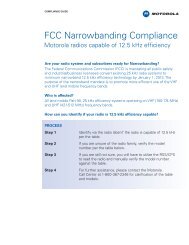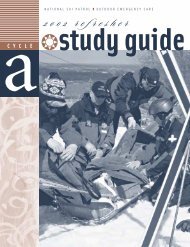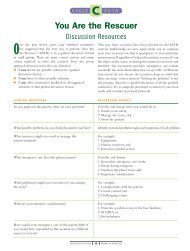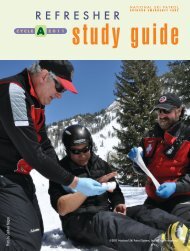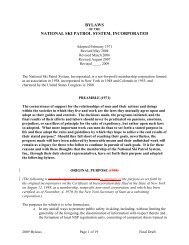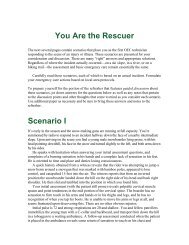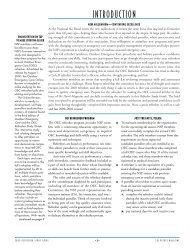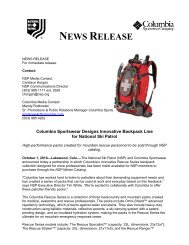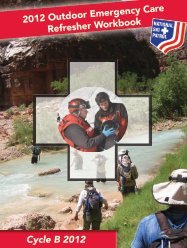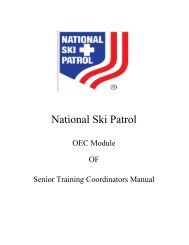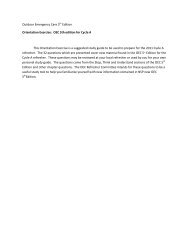Sierra Samaritans - National Ski Patrol
Sierra Samaritans - National Ski Patrol
Sierra Samaritans - National Ski Patrol
Create successful ePaper yourself
Turn your PDF publications into a flip-book with our unique Google optimized e-Paper software.
outdoor<br />
emergency care<br />
BY STEVE DONELAN<br />
that’s a wrap: wound<br />
bandaging made easy<br />
A<br />
Among the first skills that patrollers learn<br />
is how to control severe bleeding, but<br />
that’s only one aspect of proper emergency<br />
care. Because open wounds are an<br />
invitation to bacterial infection, it’s also<br />
important to know how and when to<br />
clean a wound, dress it, and secure it with<br />
an appropriate bandage.<br />
Foreign matter and dead tissue in<br />
wounds are potential growth sites for<br />
harmful bacteria that can increase and<br />
multiply in a matter of hours. If not<br />
removed, contamination in the original<br />
wound can spread infection that the body’s<br />
defenses may not be able to control—<br />
because the immune system protects only<br />
living tissue. While antiseptics may slow<br />
down bacterial growth, they are no substitute<br />
for cleaning a wound and protecting it<br />
from subsequent contamination.<br />
WOUND CLEANING<br />
Cleaning and getting debris out of a<br />
wound requires forceful irrigation and is<br />
important if the patient is two or more<br />
hours away from hospital care. Otherwise,<br />
just apply a dressing and bandage and<br />
leave the wound cleaning to the hospital.<br />
If bleeding is severe, however, you should<br />
stop the bleeding immediately without<br />
trying to clean the wound Also, never try<br />
to scrub an open wound in the field,<br />
because that will introduce more contamination<br />
and can cause further damage.<br />
When the patient is far from the hospital,<br />
flushing the wound will help ensure<br />
that it remains free of contamination that<br />
can lead to infection. Wound irrigation<br />
syringes are designed to do the job, but if<br />
you don’t have one you can improvise<br />
with a clean Ziplock® bag. Fill the bag<br />
with clean water, seal it, and punch a pinhole<br />
in a bottom corner using a penknife<br />
or small scissors. Hold the bag over the<br />
wound and squeeze. You may need to use<br />
tweezers to remove debris that will not<br />
flush out, then irrigate the wound some<br />
more. If your tweezers are not sterile, you<br />
can at least clean them with benzalkonium<br />
chloride, a standard antiseptic available<br />
on moist towelettes sealed in foil.<br />
For the last irrigation, you can use an<br />
antiseptic such as 10 percent povidoneiodine<br />
(Betadine), diluted to 1 percent by<br />
mixing one part antiseptic with 9 parts<br />
clean water. You might also put some<br />
diluted antiseptic on the dressing before<br />
applying it to the wound. However, if you<br />
don’t have Betadine, clean tap water is<br />
still very effective.<br />
While antibiotic ointments are heavily<br />
advertised, no independent studies have<br />
found that they have any antibacterial<br />
action, and there is a possibility that they<br />
may cause an allergic reaction in the<br />
patient. For wilderness situations, you<br />
might want to consider a traditional antiseptic<br />
from your food supply: honey.<br />
Many recent studies suggest that honey—<br />
especially the dark, unprocessed kind—is<br />
more effective than modern antiseptics.<br />
In Australia, medicinal honey (irradiated<br />
to make it sterile) is sold for this purpose.<br />
The sugar in honey kills bacteria by<br />
dehydrating them (which is why sugar<br />
also helps preserve food against spoiling),<br />
and unprocessed honey also has an ingredient<br />
that generates a low level of hydrogen<br />
peroxide in the wound, which acts as<br />
an antiseptic.<br />
DRESSINGS<br />
Once the wound has been thoroughly irrigated,<br />
you need to protect it. A dressing<br />
literally covers the naked wound to help<br />
prevent contamination, and a bandage or<br />
strips of tape hold the dressing in place.<br />
Sterile gauze pads are the most common<br />
dressings, especially in the 4-by-4-inch<br />
size. They are absorbent, which helps form<br />
a clot by trapping and holding enough<br />
blood for the fibrin and fibrinogen to<br />
coagulate before it can be flushed away by<br />
the flow of uncontrolled bleeding. But if<br />
bleeding is not a problem, a non-stick<br />
dressing will be more comfortable and<br />
easier to remove when it is time to change<br />
the dressing. Non-stick dressings have a<br />
porous non-adhering layer over the<br />
absorbent pads. To remove stuck dressings<br />
or tape, there are several tricks that can<br />
minimize discomfort. First, if there is hair<br />
underneath, always peel in the direction<br />
that the hair grows. Second, as you peel,<br />
dab alcohol (e.g., from an alcohol prep<br />
pad) under the stuck dressing or tape.<br />
Alcohol dissolves the adhesive.<br />
Another type of dressing, particularly<br />
useful for burns and abrasions, features a<br />
soothing water-based gel sandwiched<br />
between thin sheets of plastic. To use it,<br />
peel off the plastic from one side and lay<br />
the sheet of gel on the wound. If you are<br />
going to cover the gel with a sturdier<br />
dressing, you can also peel off the top<br />
layer of plastic. This dressing is sold under<br />
brand names such as Spenco 2nd <strong>Ski</strong>n®<br />
and Burn Aid®.<br />
THE ART OF BANDAGING<br />
Most of the traditional bandaging techniques<br />
have disappeared from emergency<br />
care courses and books, as the growth of<br />
the EMS system reduced the need for<br />
extended care by lay people; and bandages<br />
applied by urban EMTs only need to stay<br />
on during a short ambulance ride to the<br />
hospital. <strong>Patrol</strong>lers, however, still need to<br />
know how to apply bandages that will<br />
62 <strong>Ski</strong> <strong>Patrol</strong> Magazine | Winter 2005



